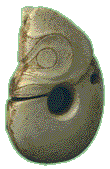


 into use
until the Ming dynasty (1368-1644). Nephrite ranges
widely in color, from pale to dark green, from white to
yellow, from brown to black.
into use
until the Ming dynasty (1368-1644). Nephrite ranges
widely in color, from pale to dark green, from white to
yellow, from brown to black.
Because of its extreme hardness, nephrite is inordinately difficult to work. It cannot be carved, but must be ground by a material harder than itself. The Neolithic tools of choice were probably a gut saw and bamboo drill together with an abrasive in the form of river sand or sludge. Finely worked pieces, discovered at sites dating as early as 7000 BCE, took the most painstaking labor to create and testify both to the central importance of these jades to early Chinese societies and to the technological sophistication of their craftsmen.
The exact function of many of the earliest jades is still unknown, although evidence points to their use in rituals relating to burial and the spirit world. Found in large numbers and in a great variety of shapes in tombs, jade-which is virtually indestructible-was probably thought to confer immortality. Between the Xia period (ca. 2100-ca. 1600 BCE) and the Han dynasty (206 BCE-220 CE), when bronze came to be the major material exploited for ritual objects, jade gradually came to be used more for adornment than for ritual. Archaeological evidence dating to the Eastern Zhou period (770-256 BCE) and Han dynasty indicates that jades, bronzes, silk, lacquerwares, and even gold shared a common vocabulary of motifs and styles, reflecting the interchange between the artists working in these mediums. At the same time, regional differences in type, decoration, and technique, as seen in the first bay, emphasize the rich diversity of China's early cultures.